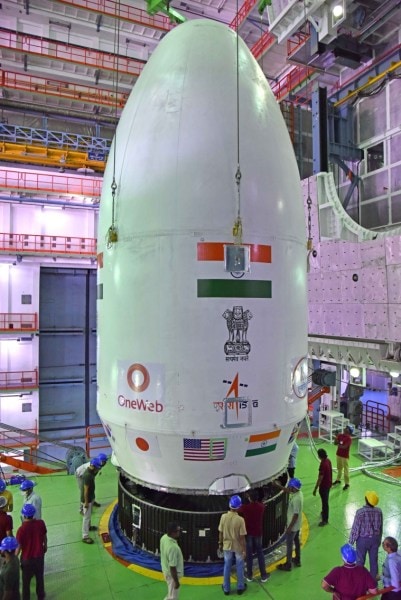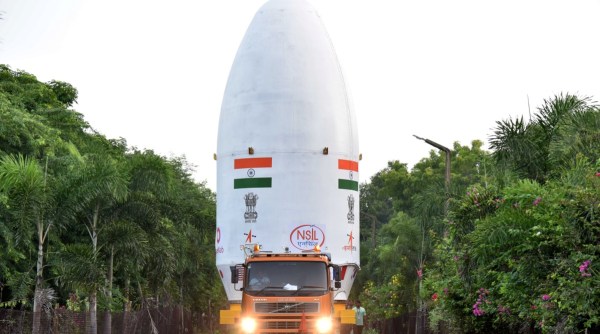Isro launches 36 OneWeb satellites precisely, completes mission of many firsts

India’s heaviest launch vehicle – which is now being referred to as the Launch Vehicle Mark III (LVM3) instead of the geosynchronous launch vehicle Mark III (GLSV-MK III) – successfully injected 36 satellites of the OneWeb broadband constellation in precise orbits in five phases early Sunday morning.
The space agency at 01:42 am announced, “LVM3 M2/OneWeb India-1 mission is completed successfully. All the 36 satellites have been placed into intended orbits,” after a tracking blackout during which 20 of the satellites were deployed.
Nearly 37 minutes after the lift-off from the second launch pad of the country’s only spaceport in Sriharikota, the Isro chairperson S Somanath said, “Sixteen (satellites) have been separated very safely as we expected and the remaining 20 satellites will be separating when we are not able to see it from this place (the rocket will be on the other side of the earth) and the data will come a little later.” The chairperson, wishing everyone a happy Diwali, said the space agency had started the celebration a little early.
During this break, he also announced that the same launch vehicle would carry another 36 OneWeb satellites in its next LVM-M3 launch.
A mission of many firsts
This was a mission of many firsts for the space agency.
This was the first foray of the LVM3 – in fact, any launch vehicle other than Isro’s workhorse PSLV – into the commercial space market. And, with it India also entered the heavier launch vehicle segment of the market. The mission, however, was not all about India positioning itself to capture a larger chunk of the commercial space sector (currently India accounts only for 2% despite being one of the foremost space fairing countries).
This was the first time that this launch vehicle carried multiple satellites and launched them is low earth orbit.
LVM3 – M2/OneWeb India-1 Mission: Launch scheduled at 0007 hrs. IST on October 23, 2022. Cryo stage, equipment bay (EB) assembly completed. Satellites are encapsulated and assembled in the vehicle. Final vehicle checks are in progress. @NSIL_India @OneWeb pic.twitter.com/pPbqjDjFmS
— ISRO (@isro) October 14, 2022
This was also the first time any of India’s rockets carried a 6 ton payload to space. The weight of the 36 satellite payload totalled around 5.8 tonne, which is the heaviest payload for the space agency to date. The LVM3 rocket has a capacity to carry up to 8 ton to low earth orbit. The PSLV is a much lighter vehicle and can carry between 1.4 to 1.75 ton payloads.
In fact, before the LVM3 was operationalized – its first operational mission after two development flight was Chandrayaan 2 – several of the 2 to 5 ton GSAT satellites were launched by European launch provider Arianespace. Two GSAT missions were flown by Arianespace even after that, with the latest being in June this year.
 The mission assumes significance as this was LVM3’s maiden commercial mission and also NSIL’s first with the said launch vehicle. (Twitter/@isro)
The mission assumes significance as this was LVM3’s maiden commercial mission and also NSIL’s first with the said launch vehicle. (Twitter/@isro)
This has also proved LVM3 to be a dependable launch vehicle, with all four missions of its missions being successful. This is essential as the vehicle is currently being human rated and will carry our astronauts to space under the Gaganyaan mission. “LVM3 is being human-rated for the human spaceflight mission Gaganyaan. And as part of human rating more confidence building tests of all propulsion systems are being conducted successfully,” said the director of Vikram Sarabhai Space Centre Dr S Unnikrishnan Nair in a video address.
Challenging mission
Other than what the mission proved about the capabilities of the space agency, the mission itself was challenging.
 This was the first foray of the LVM3 – in fact, any launch vehicle other than Isro’s workhorse PSLV – into the commercial space market. Twitter/@isro
This was the first foray of the LVM3 – in fact, any launch vehicle other than Isro’s workhorse PSLV – into the commercial space market. Twitter/@isro
United Kingdom-based Network Access Associated Limited – India’s Bharti is a major investor – plans to create 588 satellite strong constellation to provide high speed, low latency global connectivity.
These satellites will be placed in 12 rings of 49 satellites each, with every satellite completing a full trip around the earth in 109 minutes. This was the fourteenth launch for OneWeb, increasing the fleet to 464 satellites so far. The constellation is likely to be completed by next year, with ISRO launching another batch of 36 satellites.
The current mission was also a long one, totalling more than 5,500 seconds or 91 minutes from the lift-off to the deployment of the last satellite. This was because, as per the company’s demand, Isro had to ensure not only precise injection of the satellites into a 600 km orbit but also ensure that the satellites did not collide with each other during deployment or later on.
Dr Nair said, “The mission demands the separation of all 36 satellites into the 600 km orbit and the separation has to be sequenced in such a way that the customer requirement of minimum 137 metre distance between any pair of satellites is maintained. This is achieved by orienting and re-orienting the cryo stage (third stage of the rocket) using the on-board thrusters.”
Director ISRO Inertial Systems Unit Dr D Sam Dayala Dev said, “Precision injection is needed so that they do not collide during separation. Not only should they not collide, but also maintain the separation in the long term. This calls for certain manoeuvres, pointing of the launch vehicle, and adding incremental velocity between satellite separation. This needs to be done in a very precise manner.”



